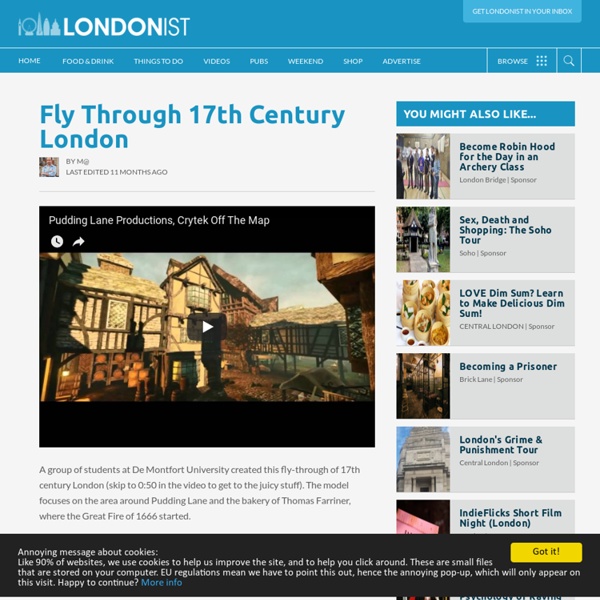Fly Through 17th Century London
M@ Fly Through 17th Century London A group of students at De Montfort University created this fly-through of 17th century London (skip to 0:50 in the video to get to the juicy stuff). The model focuses on the area around Pudding Lane and the bakery of Thomas Farriner, where the Great Fire of 1666 started. Although most of the buildings are conjectural, the students used a realistic street pattern and even included the hanging signs of genuine inns and businesses mentioned in Samuel Pepys' diary. More information on the source material and processes can be found on the team's blog. The project is an entry in the Off The Map competition, in which students were invited to build 3-D digital models based on maps at the British Library, and using software by Crytek.
https://londonist.com/2013/10/fly-through-17th-century-london
Related: Shakespeare
• h07katkar
• Shakespeare
Shakespeare In Business – 10 Quotes That Could Be Applied In Modern Business
Photo: Wikimedia Commons Well, it’s that time of year again when the English Language world pay homage to the grand master of the English Language, William Shakespeare on what would be his four hundred and fifty-first birthday! As I was thinking of a post to celebrate Shakespeare’s birthday I wondered to myself whether I could write about Shakespeare in business. Shakespeare in business?
Why Shakespeare loved iambic pentameter - David T. Freeman and Gregory Taylor
While interesting to explore in his plays, the idea of Shakespeare as a poet isn’t new. He wrote many poems. Most famously, he penned 154 sonnets that are often as studied and celebrated as his plays. His sonnets feature a specific format that uses iambic pentameter to reflect great meaning and emotion in a short burst of verse.
Origins of Shakespeare
Although he did not invent the sonnet, he did make it popular! William Shakespeare is believed to have influenced the English language more than any other writer in history, popularizing terms and phrases that still appear in everyday conversation and text. Examples include the words “fashionable” (“Troilus and Cressida”), “sanctimonious” (“Measure for Measure”), “eyeball” (“A Midsummer Night’s Dream”) and “lackluster” (“As You Like It”); and the expressions “foregone conclusion” (“Othello”), “in a pickle” (“The Tempest”), “wild goose chase” (“Romeo and Juliet”) and “one fell swoop” (“Macbeth”). He is also credited with inventing the given names Olivia, Miranda, Jessica and Cordelia, which have become common over the years.
Shakespeare Solos: watch the first six films
Adrian Lester, Hamlet ‘To be or not to be’ Adrian Lester performs Hamlet’s soliloquy from act III, scene 1, in which the prince reflects on mortality and considers taking his own life. Joanna Vanderham, Romeo and Juliet ‘The mask of night is on my face’ Joanna Vanderham speaks Juliet’s monologue from the balcony scene in which she insists that her devotion to Romeo is true even if it has been a whirlwind romance.
Shakespeare's Globe 360
Shakespeare's Globe 360 Download the Shakespeare’s Globe 360 app to experience Shakespeare’s Globe as never before. Packed with interesting facts, videos and photos; the free app allows anyone in the world to explore a virtual version of the world’s most iconic theatre.
To be or not to be? Prince Charles has the answer in fun sketch! - FluencyOnline.Com
Watch Prince Charles join a stellar cast of actors on stage including Sir Ian McKellen, Dame Judi Dench and Benedict Cumberbatch in a sketch about where to place the emphasis when delivering the lines 'To be or not to be!' from Hamlet. The sketch formed part a program that the Royal Shakespeare Theatre in Stratford-upon-Avon, used to mark the 400th Anniversary of Shakespeare's passing with this unique event. 'The event took place in the presence of their Royal Highnesses the Prince of Wales and the Duchess of Cornwall and celebrated Shakespeare's extraordinary legacy and his enduring influence on all performance art forms - from opera to jazz, dance to musicals.' BBC 2
Shakespeare's last act: a torrent of twisted fantasies
Most of us think of Shakespeare as an Elizabethan. It’s almost impossible not to. Try imagining Shakespeare in Love ending with a cameo appearance by Simon Russell Beale as King James rather than with Judi Dench’s Queen Elizabeth. But Shakespeare was as much a Jacobean writer as he was an Elizabethan one, and to forget that is to distort the trajectory of his career and play down the quite different set of challenges he faced in the decade following the death of Elizabeth in 1603.
Ten ways in which Shakespeare changed the world
Back in 2012, the British Library displayed a rare book that attracted as much media attention as a Gutenberg Bible. It was a mass-produced edition of a text once owned by Nelson Mandela, inked with his pen. Mandela had kept this volume by his bedside for more than 20 years and it had sustained him through his darkest hours on Robben Island.
Shakespeare - Hamlet
Hamlet, the Prince of Denmark, has come back from university to find that his father, the old king, is dead. His mother has married his father’s brother, Claudius, who is now king of Denmark. Hamlet is shocked that his mother has married so soon after his father’s death, and angry that she has married Claudius.
Related:



